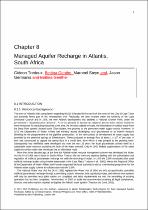JavaScript is disabled for your browser. Some features of this site may not work without it.
- ResearchSpace
- →
- Research Publications/Outputs
- →
- Book Chapters
- →
- View Item
| dc.contributor.author |
Tredoux, G

|
|
| dc.contributor.author |
Steyn, Maronel

|
|
| dc.contributor.author |
Germanis, J

|
|
| dc.date.accessioned | 2012-09-06T12:43:43Z | |
| dc.date.available | 2012-09-06T12:43:43Z | |
| dc.date.issued | 2011 | |
| dc.identifier.citation | Tredoux, G, Genthe, B, Steyn, M and Germanis, J. Managed aquifer recharge in Atlantis, South Africa. Advances in Water Reclamation Technologies for Safe Managed Aquifer Recharge. IWA Publishing. London, UK, pp 121-140 | en_US |
| dc.identifier.isbn | 978-1-84339344-3 | |
| dc.identifier.isbn | 9781780400648 | |
| dc.identifier.uri | http://www.iwaponline.com/wio/2012/wio2012RF9781780400648.htm | |
| dc.identifier.uri | http://hdl.handle.net/10204/6084 | |
| dc.description | Copyright: 2011 IWA Publishing. This is a post-print version of the work. The definitive version is published in Advances in Water Reclamation Technologies for Safe Managed Aquifer Recharge, pp. 121-140 | en_US |
| dc.description.abstract | The town of Atlantis with a population exceeding 60,000 is located 50 km north of the centre of the City of Cape Town and presently forms part of the metropolitan area. Previously, the area resorted under the authority of the Cape Divisional Council and in 1976, the new Atlantis development was declared a National Growth Point, under the government’s “decentralisation initiative”. As it was planned to become an industrial growth point various incentives were introduced for attracting industries to the area. As the west coast is semiarid, the importation of surface water from the Berg River system, located some 70km distant, was planned as the permanent water supply source. However, in 1972 the Department of Water Affairs and Forestry started developing local groundwater as an interim measure allowing for the postponement of the pipeline construction. In the early phases of development all water supply was provided by the perennial springs at Silwerstroom. These produced an average flow of about 1 x 106 m3 per year. A weir was constructed to capture the spring flow in a small dam, from which it was pumped to the growing town. Subsequently two wellfields were developed and over the next 25 years the local groundwater proved itself as a sustainable water resource providing the bulk of the water demand. Only in 2000 limited augmentation of the water supply by surface water was introduced via an alternative route. | en_US |
| dc.language.iso | en | en_US |
| dc.publisher | IWA Publishing | en_US |
| dc.relation.ispartofseries | Workflow;7106 | |
| dc.subject | Aquifer recharge | en_US |
| dc.subject | Town of Atlantis | en_US |
| dc.subject | Water supply | en_US |
| dc.subject | Water Reclamation Technologies | en_US |
| dc.title | Managed aquifer recharge in Atlantis, South Africa | en_US |
| dc.type | Book Chapter | en_US |
| dc.identifier.apacitation | Tredoux, G., Steyn, M., & Germanis, J. (2011). Managed aquifer recharge in Atlantis, South Africa., <i>Workflow;7106</i> IWA Publishing. http://hdl.handle.net/10204/6084 | en_ZA |
| dc.identifier.chicagocitation | Tredoux, G, Maronel Steyn, and J Germanis. "Managed aquifer recharge in Atlantis, South Africa" In <i>WORKFLOW;7106</i>, n.p.: IWA Publishing. 2011. http://hdl.handle.net/10204/6084. | en_ZA |
| dc.identifier.vancouvercitation | Tredoux G, Steyn M, Germanis J. Managed aquifer recharge in Atlantis, South Africa.. Workflow;7106. [place unknown]: IWA Publishing; 2011. [cited yyyy month dd]. http://hdl.handle.net/10204/6084. | en_ZA |
| dc.identifier.ris | TY - Book Chapter AU - Tredoux, G AU - Steyn, Maronel AU - Germanis, J AB - The town of Atlantis with a population exceeding 60,000 is located 50 km north of the centre of the City of Cape Town and presently forms part of the metropolitan area. Previously, the area resorted under the authority of the Cape Divisional Council and in 1976, the new Atlantis development was declared a National Growth Point, under the government’s “decentralisation initiative”. As it was planned to become an industrial growth point various incentives were introduced for attracting industries to the area. As the west coast is semiarid, the importation of surface water from the Berg River system, located some 70km distant, was planned as the permanent water supply source. However, in 1972 the Department of Water Affairs and Forestry started developing local groundwater as an interim measure allowing for the postponement of the pipeline construction. In the early phases of development all water supply was provided by the perennial springs at Silwerstroom. These produced an average flow of about 1 x 106 m3 per year. A weir was constructed to capture the spring flow in a small dam, from which it was pumped to the growing town. Subsequently two wellfields were developed and over the next 25 years the local groundwater proved itself as a sustainable water resource providing the bulk of the water demand. Only in 2000 limited augmentation of the water supply by surface water was introduced via an alternative route. DA - 2011 DB - ResearchSpace DP - CSIR KW - Aquifer recharge KW - Town of Atlantis KW - Water supply KW - Water Reclamation Technologies LK - https://researchspace.csir.co.za PY - 2011 SM - 978-1-84339344-3 SM - 9781780400648 T1 - Managed aquifer recharge in Atlantis, South Africa TI - Managed aquifer recharge in Atlantis, South Africa UR - http://hdl.handle.net/10204/6084 ER - | en_ZA |






